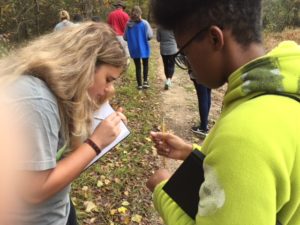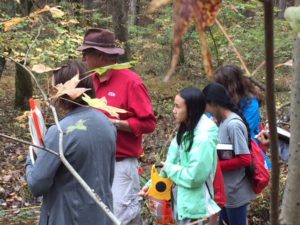Read
Immigrant Teens in the South Bronx Learn the Art of...
Teachers in the South Bronx extend opportunities for student-driven online writing projects through the Youth...
Dressed in full “Ghostbusters outfits,” a group of 15 usually quiet and introverted middle school girls are abuzz with questions and predictions as they prepare to electrically shock a pond and count its temporarily unconscious fish.
This decidedly “not school” scene is one of many such moments from Green is the New Pink, a 2017 LRNG Innovators Challenge Project conceived by University of Mississippi Director of Pre-College Programs, Ellen Shelton.
Shelton, who is also the director of the University of Mississippi Writing Project, was looking for ways to expand the University’s STEM programming for K-12 girls when she reconnected with Scott Knight, director of the University of Mississippi Field Station. Drawing inspiration from a successful ecology day-camp for elementary students, they decided to develop an environmental science program aimed at girls in their middle-school years, a time of life where many girls’ interest in STEM topics begins to trail off.
The LRNG Innovators Challenge grants are the result of a partnership between the National Writing Project and John Legend’s The Show Me Campaign. The grants support educators and projects that are expanding the time and space for Connected Learning, a theory of learning that aims to connect school work to students’ passions, peers, and out-of-school worlds.
 In its first iteration, Green is the New Pink took place over four full Saturdays at the University of Mississippi Field Station, a 787-acre research and educational complex about 11 miles away from the main University campus. Guided by a team of teachers and professional scientists, 15 girls from five different schools (grades 8-11) explored the Field Station’s trails, creeks, and mud, engaging in scientific inquiry and asking big questions about the interdependence of ecosystems and human impacts on the environment.
In its first iteration, Green is the New Pink took place over four full Saturdays at the University of Mississippi Field Station, a 787-acre research and educational complex about 11 miles away from the main University campus. Guided by a team of teachers and professional scientists, 15 girls from five different schools (grades 8-11) explored the Field Station’s trails, creeks, and mud, engaging in scientific inquiry and asking big questions about the interdependence of ecosystems and human impacts on the environment.
At its heart, the program is a chance to nurture a passion and potential career interest at a moment when many girls are turning away from science, particularly environmental science. “I think a lot of times in schools it’s not cool to be the science geek,” says Shelton. More than that, the program is combatting a stereotype that playing in the mud, taking risks, and asking questions are all the purview of boys. On this front, says Shelton, the program was a great success: “Lots of pairs of really nice new shoes were sacrificed to the mud gods. But they didn’t mind getting dirty, and they didn’t mind asking questions.”
In the field, the teaching team wove the principles and processes of scientific inquiry into the fabric of the day. The team’s science teachers made a habit of prompting the students to form predictions and hypotheses about what might be around the next turn in the trail, or about how something might have changed since the previous Saturday. The students got to observe how professional scientists took field notes and kept scientific journals, and practiced keeping notes of their own. And students got to see firsthand that asking questions without having the answers is a critical part of how real scientists do their work.
“They got to see a couple teachers saying ‘I have no idea, I have no clue what that is, that’s not my area, let’s go look, let’s go guess,’” says Shelton. At one point Dr. Knight, unable to identify a species outside of his expertise, phoned a colleague. “That was neat,” Shelton says. “They got to see there’s actually this community that helps each other discover.”
In addition to the fish counts, students engaged in water velocity and water pH monitoring, tagging birds, and checking the health of salamander eggs. One group of students became deeply engaged in learning about the interdependence of the forest ecosystem through a concept called the “wood wide web,” while another were drawn into an exploration of how human-generated microplastics were impacting the area. “It was really powerful to watch the girls engage in things they would never get to engage in at school,” says Shelton.
 Throughout the program, students formulated their own inquiry questions and experiment designs, focusing on these topics and their implications for the local food chain and human health. Due to time constraints and the students’ other summer plans, they were not able to take the next step into implementation, but Shelton is proud of the learning in evidence in the students’ proposals.
Throughout the program, students formulated their own inquiry questions and experiment designs, focusing on these topics and their implications for the local food chain and human health. Due to time constraints and the students’ other summer plans, they were not able to take the next step into implementation, but Shelton is proud of the learning in evidence in the students’ proposals.
On the program’s final Saturday, the students attended a graduate student poster session at the Field Station’s environmental science conference. The graduate students, over half of whom were female, were engaged in the same process of formulating a research proposal and experimental design, giving Green is the New Pink’s participants a close-up look at how their own work connected to a possible career.
Initially shy, the girls came out of their shells in the field, bonding over the process of shared inquiry. “What we discovered is that a lot of your environmental scientists are introverts, which makes sense because they spend a lot of time alone in the field,” says Shelton. “On the way up they were always quiet, on the way back they were dead quiet. But while we were there, that first hour they wouldn’t say anything, and then all of a sudden someone would say, ‘why does that happen?’ And someone else would say ‘I wondered that too,’ and then they would go the whole day, asking questions.”
For Shelton, this is one of the biggest signs of the program’s success, a clear indication that the team had succeeded in creating a space where gendered norms and concerns about being too nerdy had fallen away, and the girls’ shared passion for science and the outdoors could shine through.
While not all of the participants in Green is the New Pink will go on to become environmental scientists, the program gave all of the girls a chance to embrace their passion, seeing themselves as scientists both in the present and potentially in the future. It gave them a chance to bond with a peer group across rural school communities that shared their interests, and many of the girls are planning to return to the program’s second iteration this spring. And finally, it gave them a chance to grow as explorers and questioners, comfortable asking questions in a muddy creek and an academic conference room.
“We build a lot of first steps,” says Shelton. “We may not have gotten to the top of the stairs, but we built a lot of steps.”
